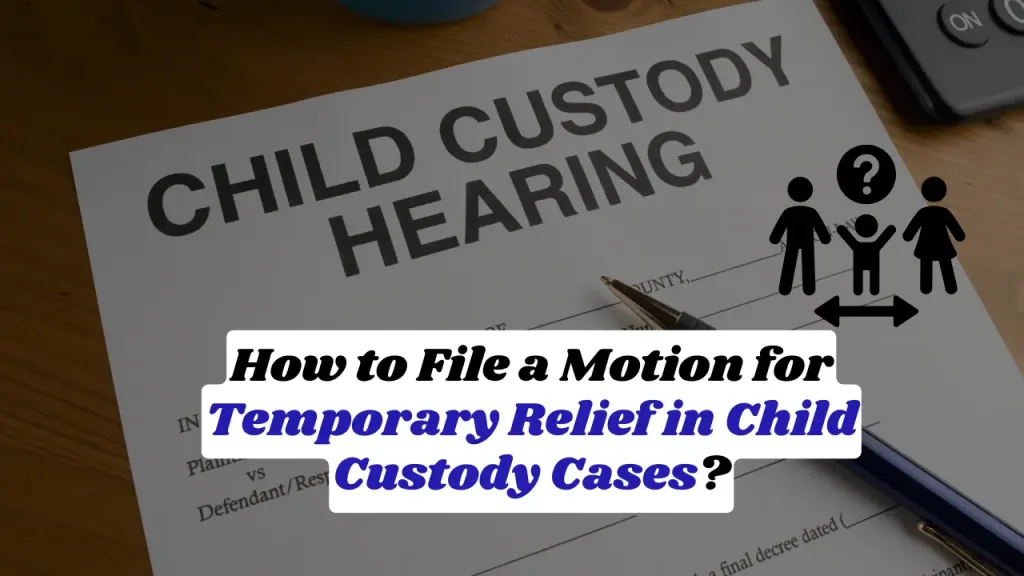How to File a Motion for Temporary Relief in Child Custody Cases?
A motion for temporary relief in child custody is a formal legal request for temporary decisions about custody, visitation, and support while the case is pending. The process typically takes 2–4 weeks to resolve and costs $200–$500 in filing fees, plus potential attorney fees. Temporary orders are crucial for maintaining stability during the often lengthy custody or divorce process.
When facing a child custody dispute, stability and protection for your child are crucial, especially during the legal proceedings that can span months or even years. Filing a motion for temporary relief allows you to address immediate issues like custody, visitation, and financial support, providing much-needed stability for the child.
This detailed guide consolidates expert insights, real-world examples, and legal processes to equip you with everything you need to successfully file a motion for temporary relief.
Table of Contents
Why File for Temporary Relief?
The Importance of Temporary Orders
According to family law statistics, 25% of custody cases require temporary relief motions to establish immediate arrangements for children’s care. These orders help maintain stability during legal proceedings, which can take 6-12 months to resolve fully. During child custody disputes or divorce cases, there’s often a temporary phase between the filing of the case and the final order, which can last 6–12 months. During this time, families need immediate solutions to pressing issues such as:
- Determining custody arrangements.
- Establishing child support to ensure financial stability.
- Setting visitation schedules to preserve parent-child relationships.
According to family law data, 25% of custody cases require temporary orders to address these urgent concerns.
Expert Insight:
“Temporary relief motions are critical tools for protecting children’s well-being during custody disputes,” says Sarah Martinez, J.D., a family law attorney with over 15 years of experience. “They provide structure and stability when families need it most.”
Related Articles For You:
Use of Mental Health Records in Child Custody Proceedings: What Parents Need to Know
What Can Be Used Against You in Child Custody Battles?

Types of Motions for Temporary Relief
A motion for temporary relief can cover several issues depending on the needs of the case, including:
- Temporary Child Custody and Visitation:
Ensures stability for the child and allows both parents to maintain a relationship while custody disputes are resolved. - Child Support:
Covers immediate financial needs for the child, ensuring essentials like education, health care, and daily expenses are met. - Spousal Support:
Provides financial assistance for a dependent spouse during divorce proceedings. - Restraining Orders:
Prevents harmful behavior, such as domestic violence or exposure to unsafe environments. - Asset Freezing Orders:
Stops either party from depleting marital assets or hiding financial resources during the case.
Step-by-Step Process for Filing a Motion for Temporary Relief
1. Gather Necessary Documents
Prepare the following documents to file your motion:
- Motion for Temporary Relief: Formally requests temporary custody or support.
- Affidavit or Declaration: Provides evidence to support your request.
- Proposed Parenting Plan: Outlines custody and visitation arrangements.
- Financial Declaration: Details income, expenses, and child-related costs.
- Notice of Hearing: Alerts the opposing party of the court hearing.
2. Draft and Complete the Motion
Clearly outline:
- Your relationship to the child and the current circumstances.
- The specific arrangements you’re requesting (e.g., custody schedules or support payments).
- Justification for the urgency, supported by evidence such as school records, medical documents, or witness affidavits.
Pro Tip: Use court-provided templates or consult an attorney to ensure accuracy.
3. File the Motion with the Court
- Submit all documents to the family court clerk.
- Pay the filing fee (typically $200–$500).
- Obtain a hearing date (often within 2–4 weeks).
- Serve the motion and notice to the other party at least 5–7 days before the hearing, as required by state law.
4. Prepare for the Hearing
Temporary hearings usually last 15–15 minutes. Follow these tips:
- Submit evidence in affidavit form. Witness testimony is generally not allowed.
- Include a financial declaration and proposed parenting plan if custody is at issue.
- Focus on the child’s best interests, emphasizing stability, safety, and emotional well-being.
5. Attend the Hearing
- Present your case clearly and succinctly.
- Answer the judge’s questions directly and professionally.
- Highlight evidence supporting the urgency of your motion.
How Temporary Relief Works in South Carolina
In South Carolina Family Court, temporary relief motions address immediate concerns during the litigation phase. This period starts when the case is filed and ends with a final order. Common issues include:
- Custody and visitation schedules.
- Child or spousal support payments.
- Division of property responsibilities (e.g., who stays in the marital home).
Timeline for South Carolina: Hearings are typically scheduled within 4 weeks, and motions must be served 7 calendar days before the hearing. Evidence is presented through affidavits rather than live testimony.
Strategic Checklist for Filing a Motion
- Gather Evidence:
- School records, medical reports, and communication logs.
- Witness affidavits supporting your claims.
- Document Current Arrangements:
- Existing childcare schedules, education needs, and financial support contributions.
- Prepare Legal Arguments:
- Highlight the child’s best interests, safety, and emotional stability.
Expert Tip: Judges value well-prepared evidence over emotional arguments.
Resources for Filing a Motion
- South Carolina Judicial Department: Family Court Rules
- Minnesota Courts: Temporary Relief Guidelines
- Legal Aid Resources for Child Custody
Conclusion
Filing a motion for temporary relief is an essential step in protecting your child’s well-being during custody disputes. By following this guide, gathering strong evidence, and focusing on your child’s needs, you can ensure a stable interim arrangement while awaiting the court’s final decision.
For personalized assistance, consult a family law attorney or explore online resources to guide you through the process. Take action today to provide your child with the stability they require.
Related Articles For You:
Substantial Change in Circumstances for Custody and Support Modifications in California
Can Smoking Weed Make You Lose Custody Of Your Child? Impact of Marijuana
FAQs About Temporary Relief Motions
How long does temporary relief last?
Temporary orders remain in effect until the court issues a final custody ruling.
Can I file without an attorney?
Yes, but consulting a family law professional is recommended to ensure compliance with legal procedures.
What happens if the other parent objects?
The court will consider both sides during the hearing and make a decision based on the child’s best interests.
About the Author

Sarah Klein, JD, is a former family law attorney with over a decade of courtroom and mediation experience. She has represented clients in divorce, custody cases, adoption, Alimony, and domestic violence cases across multiple U.S. jurisdictions.
At All About Lawyer, Sarah now uses her deep legal background to create easy-to-understand guides that help families navigate the legal system with clarity and confidence.
Every article is based on her real-world legal experience and reviewed to reflect current laws.
Read more about Sarah
